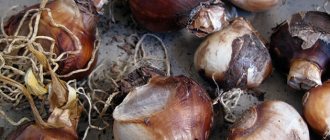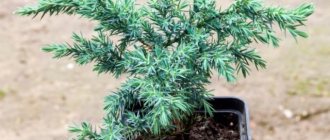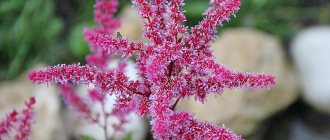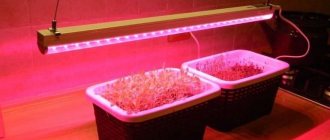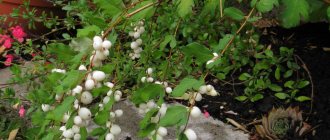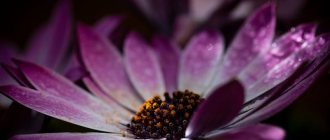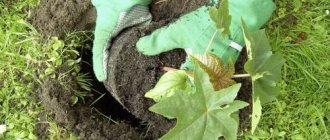- Delphinium: care in autumn after flowering
- Delphinium: care in autumn and preparation for winter
- Wintering delphinium
For delphinium flowers, preparing for winter is an important process of caring for the plant. All procedures must be carried out correctly so that the flowers overwinter safely and do not die.
Delphinium: care in autumn after flowering
This plant blooms with large beautiful candles. The color of delphinium can range from blue to dark blue and purple. After the second flowering, seed pods are collected. The collected seed is first dried and then:
- one part is prepared and sown in the ground before winter;
- the second part is hermetically packaged in glass jars and placed in a cool, dark place.
Growing delphinium from seeds is carried out with all the recommendations and advice of gardeners. The flower blooms 2 times a season and after flowering, if it is not left for self-sowing, the inflorescences are cut off and leaves and stems are left. This is necessary so that the plant continues to produce useful substances for its own nutrition and growth. 3-4 weeks after removing the “candles” that have bloomed, new shoots begin to appear in the area of the cut. In the fall, thinning is done similar to the spring, that is, 3 strong shoots are left, and all the rest are broken out. When the leaves on the old stems turn completely yellow, they are cut off and a stump of no more than 30 cm is left. If the cut stem is left taller, this will serve as an obstacle to the flow of air and water through the hollow structure to the roots, which may contribute to rotting of the root collar.
The second flowering begins approximately 4 weeks after the first in August, early September. Delphinium pruning for the winter is done in exactly the same way as at the beginning of summer, after the first flowering. Pruning of inflorescences and stems must be carried out correctly and competently. After all, its subsequent development, growth and flowering depend on proper pruning. But when cutting the stems, the supply of nutrients necessary for the development of new buds and the formation of seeds is disrupted. After summer pruning, the buds of new shoots are much weaker and the seeds may not ripen. Flowers that have not undergone primary pruning have stems that remain until the seeds are fully ripened; next year they bloom much better than those plants that have been pruned.
Watch a video about preparing delphinium for winter.
Delphinium: care in autumn and preparation for winter
In order for the plants to bloom well next year, caring for them does not stop until the cold weather and the beginning of frosts. If it’s a dry autumn, without rain, the flowers continue to be watered, since they love moisture. These autumn waterings are very useful for the successful wintering of delphiniums.
In autumn, with the onset of frost, delphiniums begin to prepare for winter:
- stems are cut to a height of 25-30 cm from the surface of the ground;
- garbage and dry leaves around are collected and burned;
- pull out all the weeds with their roots, freeing the area from them, then loosen the soil;
- remove the stakes to which the flowers were tied;
- cut stems are bent down or the top is covered with clay so that moisture does not get inside the hollow stump and the roots do not rot.
Florist specialists still do not have a consensus on leaving unpruned or leaving stumps exactly 30 cm high. According to the majority, pruning is simply necessary, but the stems need to be covered with clay on top so that melting snow does not fall through the hollow stem to the roots of the delphinium. When the rhizome rots, the plant will become sick and die. The possible level of melt water should be lower than the height of the left stem; for this, the climatic conditions of the location of the area where the delphiniums are planted are taken into account.
Wintering delphinium
These plants are considered frost-resistant, subject to snowy winters. When the stems are completely covered with snow, they can withstand up to 50 degrees of frost and not die. Under climatic conditions where the winter is warm and with little snow, with frequent thaws, they most often die if they are not properly prepared for winter.
Read about proper pruning of currants in the fall. And also about pruning jasmine bushes.
Therefore, gardeners use 2 types of preserving these plants in winter:
- The cut stems are covered with clay, and the near-root areas of the soil are sprinkled with mulch. This method is suitable for frosty, snowy winters.
- The stems are trimmed, covered with clay or garden varnish, and covered on top, usually with pine paws, so that everything is preserved and does not die. This method is suitable for wet winters.
If you prepare the flower in time for the dormant period in the fall, you can avoid the increased threat of disease. If pruning is done at the wrong time, the buds will not fully develop, and the plant will be unprepared for winter. In the fall, you should not stimulate the formation of buds; repeated flowering will greatly harm the plant. It is best to prune delphinium stems when persistent cold weather sets in.
Young flowers that were planted in the spring continue their development and growth until the cold weather. They may be in the budding stage in late autumn and it is not clear whether they are ready for wintering or not. In young plants, by late autumn the processes of bud formation have already occurred. New delphiniums tolerate winter well, but they are less susceptible to root rot than adult plants. In areas where there are warm winters with frequent thaws, a kind of hut is built for young flowers, protecting young shoots from gusts of wind and excess moisture.
In places where winters are very cold and there is a lot of snow, it is advisable to cover new plants with straw or pine branches. There is no need to use tree leaves or peat for covering; they retain moisture, promote fungal infections and attract slugs. As soon as the snow melts, in early spring, with night frosts of -5 degrees Celsius, delphiniums begin to wake up. Plants that are weakly rooted should be deepened into the soil to avoid damaging the buds.
For such a beautiful plant as delphinium, care and cultivation, as well as wintering, should be carried out in accordance with the recommendations and advice of experienced gardeners. In this case, the delphinium will be healthy and bloom for many years, decorating garden beds with its flowers.
Share your experience of preparing flowers for winter in the comments. And also watch a video on how to properly prepare perennial flowers for wintering.
The sky-blue flowers of the plant with the gentle name “delphinium” can add freshness and charm to any flower garden. Among the many varieties of delphinium, perennials are especially popular, as they are extremely unpretentious and easy to care for. Autumn care for delphinium usually comes down to loosening the soil in the garden bed and abundant watering. The only questions that usually cause difficulties for inexperienced gardeners are pruning the delphinium and preparing it for winter.
How to prepare delphinium for winter?
Thanks to its high winter hardiness, delphinium can survive winter with frosts down to -50 degrees even without any preliminary preparation. But this is only possible if they spend the winter under a thick layer of snow. In modern winters, which, as you know, bring rain much more often than snowfall, delphinium faces two main dangers: rotting and damping off.
That is why it is important not to let the process take its course and be sure to prune the delphinium for the winter. This must be done after the ground part turns yellow and dies. When pruning, it is necessary to leave the stumps of the stems at least 15-20 cm high. The fact is that the stems of this plant have a tubular structure, and if you cut them lower, then during thaws or rains, water will flow directly to the rhizome, causing it to rot.
Additionally, you can protect the plant from death using ordinary clay, covering the cuts of the stems with it. In conditions of particularly harsh snowless winters, you can additionally insulate the delphinium by covering it with a layer of fallen leaves, any organic mulch (peat, sawdust) or spruce branches. But it is possible to organize a shelter only after a steady drop in temperature, otherwise the rhizome risks simply drying out.
Delphinium is native to Asia, Europe and North America and belongs to the buttercup family. It has long and firmly occupied one of the places of honor in the gardens of Russian flower growers.
Thanks to its impressive growth and lush pyramidal inflorescences, it goes well with other flowering plants and is often used in the background design of mixborders.
This perennial plant has many varieties, which are usually united under the common name “Cultivated Delphinium”. They differ in height, shape of flowers and their color - from blue, light blue and violet to boiling white and pink.
Why delphiniums don’t always overwinter well and how to fix it
There are several possible reasons for the death of delphiniums during wintering.
Unsuitable climate
Species delphiniums of the Russian flora and garden varieties from the Belladonna and Marfin hybrid groups winter well in central Russia and Siberia, withstanding frosts down to -45 degrees in the presence of stable snow cover. And in southern regions with regular winter thaws, they often die from sudden temperature changes. New Zealand and Pacific delphiniums need a mild subtropical climate, but in the central regions of Russia they simply freeze out. The correct choice of variety is the main condition for successful wintering.
Varieties of delphiniums with pink and white flowers are more capricious than those with blue, light blue and violet.
Pink varieties of delphiniums are more capricious than blue ones
Dampness
All delphiniums are afraid of excess dampness, especially in winter. When overwatered, their rhizomes rot and die. Therefore, these flowers should be planted in elevated areas with good drainage. There are also recommendations on the Internet before the onset of winter to cut off their stems at a height of 10–30 centimeters from the soil surface and cover the cuts with clay. They also suggest breaking the stems to prevent water from getting inside.
Incorrect pruning
Many gardeners, wanting to get delphiniums to bloom again, cut off their stems at the root immediately after flowering to encourage the growth of new shoots. But these manipulations greatly weaken the plants, and such bushes often die in winter. To keep delphiniums strong and healthy, after flowering you need to cut off only the inflorescence itself above the topmost leaf. To obtain seeds, it is better to leave only one faded stem on the plant, shorten the rest, leaving all the leaves.
Features of autumn care and preparation for winter for different types and varieties of delphiniums
Gardeners' opinions about the winter hardiness of delphiniums are divided: some consider these flowers to be unpretentious and problem-free, while others, on the contrary, classify them as capricious garden sissies. In fact, both are right in their own way, because delphiniums are very diverse, and their different species and varieties have very different biological characteristics.
Annual delphiniums
Annual delphiniums are very unpretentious and grow well from the northernmost to the southernmost regions. To have these flowers in your garden every year, you just need to collect the seeds that ripen in September from the pods on the plants that begin to open in the fall. You can sow from the moment the seeds ripen until the soil freezes, immediately in a permanent place well lit by the sun. The depth of seeding when sowing is about 5 millimeters.
Annual delphiniums are easy to grow from seeds
Perennial delphiniums
The rules for autumn pruning of delphiniums given at the beginning of this article are the same for all perennial species and varieties.
In unfavorable conditions, perennial delphinium species often behave like annuals or biennials and die after the first flowering. They can also be obtained from their own seeds in the same way as the annual varieties described above.
Beautiful wild delphiniums grow in nature in central Russia and Siberia
For many years now, garden delphiniums, once planted by my grandmother, have been growing in my garden, actively reproducing by self-sowing, which results in a variety of blue, indigo and purple flowers. I don’t do anything special with them in the fall; they winter just fine under the snow. Old specimens disappear over time, but new seedlings grow on their own to replace them.
Unpretentious perennial delphiniums on video
Natural species delphiniums and old varieties from the Belladonna group
For the middle zone and Siberia, these are absolutely winter-hardy plants; in the presence of snow, they do not require any additional winter shelter.
Old garden varieties from the Belladonna group are unpretentious and winter-hardy
Marfin hybrids
These wonderful varieties of selection near Moscow successfully combine the winter hardiness of our wild delphiniums with luxurious flowers that are not inferior to foreign hybrids. In the central and northern regions they spend the winter without shelter.
Marfinsky hybrids - luxurious winter-hardy delphiniums of Russian selection
Pacific and New Zealand hybrids
Created in a subtropical climate, therefore in Russia they grow normally only on the Black Sea coast. In the Moscow region they can survive the first winter when covered with spruce branches, but after the first flowering they usually die.
Pacific hybrids - delphiniums for subtropical climates
When to sow delphinium before winter?
» Other »
Loading…
Question for experts: When should you plant canna and delphinium?
Sincerely, Elena
Best answers
Delphinium, as a perennial with a stem system, is best propagated by seeds; they can be sown in early spring, but it is better before winter - after freezing they sprout more quickly. As for cannas from seeds - I don’t know, I’ve never heard of them, but I planted seedlings - this is done around mid-May, they are very heat-loving, and in October they dig them up - and into a dry basement. True, there is new information - you can not put it in the basement, but in a large pot and in an apartment; for some, it blooms again in winter.
On the packages it says early in the spring. I planted them and they didn’t grow.
Delphinium can be grown before winter or in spring after stratification. Dig up cannes in the fall and store the rhizomes all winter at a temperature not lower than -5, and in March plant them for germination, and after the threat of frost, go into the garden. Of course, it depends where you live...
Reviews
There is a little trick for successfully wintering delphiniums: the stems must be broken and bent to the ground, and not cut into a stump, as we usually do with other perennials. Delphiniums have a hollow stem and, if you cut it, water gets in with the autumn rains. But delphiniums don’t like it too much, they get wet.
Olyunka
https://dacha.wcb.ru/lofiversion/index.php?t1206.html
But the stems are so fragile that it is not always possible to break them - they break completely. You can then put on the smallest plastic bags and wrap them with an elastic band.
Evgeniya
https://dacha.wcb.ru/lofiversion/index.php?t1206.html
I read somewhere that when cutting, you need to leave the stem 10 cm from the ground and bend it so that moisture does not get on the rhizome.
Galiy
I only cut it in the fall, about 10 centimeters, and I don’t bend anything. I do not stimulate a second flowering, and only early varieties can bloom again.
Ninulia
How to sow spur grass
Dried spur seeds are distributed over the surface of the soil in a container, small ones are left on top, large ones are slightly buried in the soil with the sharp end of a wooden toothpick or a pointed match.
The seeds are sprinkled with a light layer of soil on top, otherwise the first watering will wash them away in one heap. The container is covered with a lid and placed for stratification in the refrigerator, where the temperature is maintained at about 0 degrees.
Stratification of delphinium seeds can be carried out outdoors by burying a container with seeds deep in the snow, but this procedure can only be planned with slight temperature fluctuations from +3 to -5C. In severe frosts, it is preferable to keep the container with seeds in a household refrigerator.
Germination of fresh seeds during stratification begins in the second week, after about 10-14 days. As soon as green loops of sprouts appear on the surface, stratification is stopped and the container is transferred to a bright place. Growing seedlings continues at temperatures from 15 to 18C.
Delphinium: care in autumn after flowering
This plant blooms with large beautiful candles. The color of delphinium can range from blue to dark blue and purple. After the second flowering, seed pods are collected. The collected seed is first dried and then:
- one part is prepared and sown in the ground before winter;
- the second part is hermetically packaged in glass jars and placed in a cool, dark place.
Growing delphinium from seeds is carried out with all the recommendations and advice of gardeners. The flower blooms 2 times a season and after flowering, if it is not left for self-sowing, the inflorescences are cut off and leaves and stems are left. This is necessary so that the plant continues to produce useful substances for its own nutrition and growth. 3-4 weeks after removing the “candles” that have bloomed, new shoots begin to appear in the area of the cut. In the fall, thinning is done similar to the spring, that is, 3 strong shoots are left, and all the rest are broken out. When the leaves on the old stems turn completely yellow, they are cut off and a stump of no more than 30 cm is left. If the cut stem is left taller, this will serve as an obstacle to the flow of air and water through the hollow structure to the roots, which may contribute to rotting of the root collar.
The second flowering begins approximately 4 weeks after the first in August, early September. Delphinium pruning for the winter is done in exactly the same way as at the beginning of summer, after the first flowering. Pruning of inflorescences and stems must be carried out correctly and competently. After all, its subsequent development, growth and flowering depend on proper pruning. But when cutting the stems, the supply of nutrients necessary for the development of new buds and the formation of seeds is disrupted. After summer pruning, the buds of new shoots are much weaker and the seeds may not ripen. Flowers that have not undergone primary pruning have stems that remain until the seeds are fully ripened; next year they bloom much better than those plants that have been pruned.
Watch a video about preparing delphinium for winter.
Delphinium: planting and care in open ground
You can admire the beauty of the flowers only if the right place and soil are chosen for growing delphinium. Good growth and abundant flowering cannot be achieved when planted in highly acidic soil. The plant prefers the neutral reaction of fertile soil and does not like acidic soil. If the site has predominantly acidic soil, it should be prepared in the fall. It is recommended to add 100 g of dolomite flour or lime per 1 m2. In addition, nitrogen-containing fertilizer - manure - must be added to the soil to enrich it with nutrients.
You need to grow the flower in an area sheltered from the winds. It is advisable to plant it in an open sunny place, as the New Zealand perennial needs bright light. Sometimes flowers can burn out in the midday heat.
Delphinium perennial: planting
Freshly harvested seeds give 100% germination; last year's seed or 3-year-old seed may lose germination by 50%. After collection, the seeds must be sown directly in the garden bed or in containers. The optimal period is October, November, in accordance with the lunar calendar. When sowing in spring, it is recommended to carry out preliminary stratification.
When and how to sow delphinium? Seeds are sown in the designated rows on the garden bed, superficially in containers, and then sprinkled with soil.
The beautifully flowering crop propagates by shoots. They are planted in autumn or spring. During the process of vegetative growth, the bushes increase green mass over the season, so when planting it is important to maintain a distance between plants, leaving at least 50 cm.
How to plant delphinium correctly? To plant shoots, dig holes, fill them with fertile soil, apply mineral fertilizers, and add compost. When planting the plant, they try to deepen the root collar no more than 2 cm. When the shoots reach a height of 10 cm, the shoots need to be thinned out.
Plant care
Fertilizer application promotes good growth and flowering of the plant. The first feeding is carried out in mid-spring. At this time, the delphinium needs nitrogen supplements. They contribute to the growth of green mass. At the beginning of summer, you should feed the plantings a second time, during budding. At this stage of development, plants need phosphorus and potassium fertilizers. It is recommended to add a little nitrogen fertilizer.
Phosphorus-potassium fertilizers are applied after the buds fall off. It is not recommended to add nitrogen, as the plantings will survive the winter worse.
Delphinium: care in autumn and preparation for winter
In order for the plants to bloom well next year, caring for them does not stop until the cold weather and the beginning of frosts. If it’s a dry autumn, without rain, the flowers continue to be watered, since they love moisture. These autumn waterings are very useful for the successful wintering of delphiniums.
In autumn, with the onset of frost, delphiniums begin to prepare for winter:
- stems are cut to a height of 25-30 cm from the surface of the ground;
- garbage and dry leaves around are collected and burned;
- pull out all the weeds with their roots, freeing the area from them, then loosen the soil;
- remove the stakes to which the flowers were tied;
- cut stems are bent down or the top is covered with clay so that moisture does not get inside the hollow stump and the roots do not rot.
Florist specialists still do not have a consensus on leaving unpruned or leaving stumps exactly 30 cm high. According to the majority, pruning is simply necessary, but the stems need to be covered with clay on top so that melting snow does not fall through the hollow stem to the roots of the delphinium. When the rhizome rots, the plant will become sick and die. The possible level of melt water should be lower than the height of the left stem; for this, the climatic conditions of the location of the area where the delphiniums are planted are taken into account.
Wintering delphinium
These plants are considered frost-resistant, subject to snowy winters. When the stems are completely covered with snow, they can withstand up to 50 degrees of frost and not die. Under climatic conditions where the winter is warm and with little snow, with frequent thaws, they most often die if they are not properly prepared for winter.
Therefore, gardeners use 2 types of preserving these plants in winter:
- The cut stems are covered with clay, and the near-root areas of the soil are sprinkled with mulch. This method is suitable for frosty, snowy winters.
- The stems are trimmed, covered with clay or garden varnish, and covered on top, usually with pine paws, so that everything is preserved and does not die. This method is suitable for wet winters.
If you prepare the flower in time for the dormant period in the fall, you can avoid the increased threat of disease. If pruning is done at the wrong time, the buds will not fully develop, and the plant will be unprepared for winter. In the fall, you should not stimulate the formation of buds; repeated flowering will greatly harm the plant. It is best to prune delphinium stems when persistent cold weather sets in.
Young flowers that were planted in the spring continue their development and growth until the cold weather. They may be in the budding stage in late autumn and it is not clear whether they are ready for wintering or not. In young plants, by late autumn the processes of bud formation have already occurred. New delphiniums tolerate winter well, but they are less susceptible to root rot than adult plants. In areas where there are warm winters with frequent thaws, a kind of hut is built for young flowers, protecting young shoots from gusts of wind and excess moisture.
In places where winters are very cold and there is a lot of snow, it is advisable to cover new plants with straw or pine branches. There is no need to use tree leaves or peat for covering; they retain moisture, promote fungal infections and attract slugs. As soon as the snow melts, in early spring, with night frosts of -5 degrees Celsius, delphiniums begin to wake up. Plants that are weakly rooted should be deepened into the soil to avoid damaging the buds.
How to cover perennials for the winter - chrysanthemums, delphiniums, irises
Hibiscus
.
Several types of hibiscus are grown as perennial herbaceous plants. Most often in cultivation there are hybrid varieties of F.N. Rusanov and their seedlings. In autumn, the stems, the height of which can exceed two meters, are cut off close to the ground, then soil is poured onto the bush (similar to how bush roses are covered). Dry leaves are poured over the formed mound or covered with coniferous spruce branches. With the onset of spring, the shelter is removed. It must be taken into account that new shoots grow later, so you should not rush to consider the plant dead.
Perennial delphiniums, as a rule, overwinter without shelter, but it is advisable to cover varieties from the “Pacific” group with dry leaves from frost.
Of the irises, the xiphoid iris and its Japanese varieties need shelter for the winter. In autumn, the aboveground part of these plants is cut off, and the rhizomes are covered with dry leaves.
For the winter, the leaves and stems of Kniphofia are cut off, and the bush is well covered with dry leaves, on top of which it is advisable to place spruce branches or cut stems of perennials. You can dig up a bush with a lump of earth in late autumn and (without shaking off the soil) place it in a basement or cellar.
Recommended for you:
Cortaderia, pampas grass
.
Growing this grass is possible only with very good shelter for the winter. It is better to cut the stems and cover the bush with dry leaves, filling them with a mound (up to 1.5 m in height), and on top of the leaves put cut stems of perennials or, if there is any, spruce branches.
Daylilies (both species and hybrid varieties) do not need shelter. The exception is evergreen and semi-evergreen varieties. They need to be covered with dry leaves.
Miscanthus chinensis and its varieties “Zebrinus” and “Strictus” are commonly found in cultivation. When cold weather sets in, the stems of the plants are cut off, and the bushes are covered with dry leaves, on top of which the stems of perennials and annuals cut for the winter can be placed.
Most species of hellebores and their cultivars are wintergreens, meaning their leaves remain green during the winter and die back in the spring. To keep the leaves until spring, the plants need to be covered so that the leaves are also protected. This should be a light, loose cover with spruce branches or cut stems of flower crops. Leaves are also preserved under the snow cover, but there is no guarantee that snow will fall before the onset of frost. In general, freezing of leaves has virtually no effect on the spring growth and flowering of hellebores. However, if the developed buds and flowers of hellebore are exposed to severe frost in early spring, they may freeze. A light shelter will keep them safe.
Unlike the common cornflower, the cornflower needs shelter for the winter the most. For successful wintering, a light cover with dry leaves is sufficient.
Primulas, overwintering with or without leaves, equally need shelter with dry leaves. They spend the winter under the snow without shelter, but it is quite difficult to predict what type of winter (snowy or not) it will be.
This plant is covered with dry leaves for the winter in a layer 10-15 cm thick.
All types of tricirtis need good cover with dry leaves, cut stems of flower crops or spruce branches.
Since this plant does not grow in individual bushes, but occupies a certain area, it is necessary to cover this entire area. Cover with dry leaves in a layer 12-15 cm thick. In spring, houttunia grows late, and due to inexperience, you can decide that it has died and dig up the ground.
Korean chrysanthemums shelter.
After trimming the above-ground part of the chrysanthemum bush, it is covered with dry leaves. But you can also dig up a bush, plant it in some container and put it in a cellar or basement. And the bushes of Korean chrysanthemums that have overwintered in the ground in the spring should be divided and transplanted to a new place.
All types of horny weed are winter-green plants, and in the absence of snow cover, the leaves may freeze. To preserve the leaves, you need to cover the bushes with cut stems of flower crops or spruce branches.
Picking delphinium seedlings
The recommended timing for picking delphinium seedlings occurs at the moment when the first 2-3 true leaves . It is necessary to dive into separate containers, for example, plastic cups, cassettes. The container for picking should have a volume of 0.3-0.5 liters.
And the soil can be used the same as for the initial planting of seeds, but it is recommended to add complex mineral fertilizer to it, including potassium, nitrogen, phosphorus (fertilizer is applied in the ratio of one tablespoon per 5 liters of soil).
You need to plant delphinium seedlings according to the following scheme:
- An hour before the procedure, water the container to make it easier to remove the seedling.
- Pour soil into the planting container and make a depression that matches the size of the seedling's earthen ball.
- Water the soil in the new container.
- Now you need to remove the seedlings along with a lump of earth; if the seeds were planted in a common box, then carefully separate the seedlings using a plastic fork or spoon without destroying the lump of earth.
- Transfer the seedlings to a new container, cover with soil, and bury the plants in the soil until the true leaves grow.
- Gently compact the soil.
Note! You need to care for spur seedlings after picking in the same way as before the procedure. But after diving, you need to water the plants for the first time only after a week.
Video: picking delphinium seedlings.
Features of growing delphinium
When growing larkspur, you should pay attention to the following features:
- Landing method.
- Soil composition.
- Landing place.
The flower is grown from seeds or seedlings, propagated by cuttings or dividing the bush. Seeds are sown in boxes in early spring (March) and kept in a cool place so that the sprouts do not stretch too much. Some of the seedlings may germinate with their roots up, so they are carefully turned over with tweezers and sprinkled with soil.
Rules for planting delphinium
Growing delphinium requires compliance with certain conditions regarding the location of the site, soil composition and planting method. All these factors directly affect the growth and development of the plant.
When choosing a place to plant delphinium, it is recommended to give preference to the eastern side of the garden plot. It is important that the plantings are protected from draft winds and bright midday sun. When exposed to direct sunlight, the decorative qualities of delphinium may suffer. Gusts of wind are also dangerous for this crop and can damage or break its stems.
Delphiniums prefer loose, acidic soils. To make the soil on the site more nutritious, you should fertilize it in advance by adding compost or humus. A good top dressing is wood ash, which should be mixed with garden soil in a ratio of 2 cups of ash per bucket of soil.
There are several ways to propagate delphinium: seed sowing, propagation by cuttings and dividing the bush, as well as planting ready-made seedlings.
Sowing seeds requires quite a lot of effort on the part of the gardener and includes a preliminary preparation stage. In this process, the seeds are sown in containers with nutrient soil and kept in a cool room for some time - this will prevent the sprouts from stretching out too much. The best time for sowing delphinium seeds for seedlings is March. The difficulty with germinating seeds is that some of them may germinate with their roots upward. Such sprouts must be turned over with tweezers and covered with soil again. Another problem with the seed propagation method is the uneven germination of seeds. For this reason, many gardeners prefer to purchase ready-made seedlings and plant them in open ground.
The cutting method also requires additional effort. First you need to cut the cuttings, for which lengths of shoots about 8 cm long with a heel are suitable. Then they need to be placed in containers with a nutrient soil mixture with added sand and placed in a greenhouse. After the cuttings have formed their own root system, they can be transplanted into open ground.
It is much easier to divide an adult delphinium bush and get new seedlings. It is enough to remove the plant along with the root system from the ground, make sure there is no damage, and then divide it into several parts. Each division should have healthy root shoots and shoots with several buds.
Rooted cuttings and seedlings can be planted in open ground in the second half of April. The planting holes must be spacious enough, since the delphinium has a branched root system. The optimal size is 0.4-0.5 m in diameter and the same in depth. The interval between planting holes should be at least 0.6 m so that growing seedlings do not interfere with each other.
Feeding, watering and care for delphiniums during the growing season
In order for larkspur to develop faster, it is fed several times a year with organic and inorganic compounds. For the first time (in May), shoots 10-15 cm long can be watered with mullein solution (1 bucket of manure per 10 buckets of water). This amount is enough for 10 plants.
Young plants require more watering. In the first year, their roots are moistened once a week with 2-3 liters of water. If the summer in the region is hot and dry, the delphinium is watered even more abundantly during the formation of inflorescences. After the procedure, the soil is loosened to a depth of 4-5 cm.
When the stems reach a height of 40-50 cm, at some distance from them (so as not to damage the root system), 3 metal rods or wooden pegs are driven into the ground. They should rise 170-180 cm above the ground and serve as a support for larkspur. The stems are carefully tied to rods and stakes using thin strips of fabric so that the plants are not injured during bad weather. When the delphinium grows to 1 m, its second garter is performed.
Sowing delphinium seeds before winter
The plant prefers sunlit areas, but to maintain bright colors, shading from the midday sun is desirable. Most varieties are tall, with fragile stems, so they choose places protected from the wind.
Sandy or loamy soil, rich in humus, with moderate moisture is suitable for flowers. If the acidity is high, it must be limed.
Proper cultivation of delphiniums
Planting and caring for delphiniums has a number of features. Plants are planted in late August - early September, so that they take root before the onset of frost. The distance between individual specimens depends on the species and variety; for tall hybrids it is 50-60 cm. When planting, the root collar and renewal buds are left at ground level, the seedlings are watered; in dry weather, watering continues for several days. Before the onset of cold weather, keep the soil loose and free from weeds.
Watering should be rare but plentiful, followed by loosening the soil; in dry months, one bush needs 20-30 liters of water per week. Moisture is especially necessary during the formation of inflorescences.
Over the course of a season, plants build up a powerful vegetative mass and bloom profusely; they do not have enough nutrients added to the holes during planting and need regular feeding. The first is carried out in the spring, when shoots grow to a height of 10-15 cm, using mineral fertilizers or organic fertilizers in liquid form.
In the second feeding, during budding, increase the dose of potassium and phosphorus. For the third, carried out after flowering at the time of the formation of renewal buds, only phosphorus and potassium are used. Mulching with a layer of peat or rotted compost 2-3 cm thick has a beneficial effect on the condition of the bushes.
An important technique is thinning, which allows you to obtain larger and denser inflorescences. When the height of the stems reaches 20-30 cm, weak shoots are broken off at the root collar, leaving no more than 3-5. To improve ventilation of the bush, the stems are removed from its central part. Thinning can be carried out in the fall, breaking out excess renewal buds, this will accelerate the development of shoots in the spring.
Growing delphiniums in the photo
For successful cultivation, delphiniums need a garter that prevents both breakage of fragile stems at the root collar and damage to heavy, dense inflorescences. The first garter is carried out at a height of 40-50 cm, the second - 100-120 cm, in varieties with massive inflorescences they are additionally tied in the lower and middle parts. At least 3 supports up to 180 cm high are used per bush.
If there is no need to save the seeds, the wilted inflorescences are removed.
In the fall, after the above-ground part has dried, the stems are cut off, leaving a stump of 20-30 cm, which helps protect the rhizomes from moisture and rotting during the dormant period. Sometimes the cut of the hemp is closed by covering it with clay.
Delphiniums are frost-resistant; under a layer of snow they can withstand up to -50 ° C; only in snowless winters do they require shelter. They grow in one place for up to 5-8 years.
Propagation of delphiniums by seeds: from planting to seed collection
Annual species are propagated by seeds, perennials by seeds, cuttings and dividing the bush. In the middle zone, all delphiniums are planted with seeds in March. They use seedling boxes and soil made from humus, turf soil and peat. The seeds are laid out on the surface, lightly pressed, watered and covered with a 2-3 mm layer of soil. The boxes are covered with paper or other dense material, since germination slows down in the light. At a temperature of 12-15°C, sprouts appear after 8-10 days, after 30 days they are planted at a distance of 3-4 cm.
They are planted in open ground in April-May; young plants are not afraid of frost. Delphiniums from seeds sown in spring bloom in August. It is possible to sow directly into the ground in autumn or before winter. In this case, in October-November, the seeds are laid out in grooves, sprinkled and covered with spruce branches. To plant delphiniums before winter, when stable frosts set in, the seeds are sown in pre-prepared grooves, covered with dry soil and also covered. In the spring, after the emergence of seedlings, the cover is removed.
Planting delphiniums in autumn and winter is not practiced for varietal plants.
Delphinium in the photo
Since it is rarely possible to grow delphiniums of hybrid varieties from your own seeds, since their parental characteristics are usually not inherited, these flowers are propagated by dividing bushes or cuttings. For cuttings, in May or August, young shoots growing from the root collar are cut off and rooted in the usual way. The bushes are divided in the spring, 3-4 year old rhizomes are cut along the growth of old shoots into 4-10 parts so that each has at least one shoot or renewal bud and a sufficient number of adventitious roots.
Statistics
Copyright © 2008-2018 Flower Bank. All rights to the material belong to the owner of the FlowerBank.ru website.
When using encyclopedia materials, a clickable link to the source: Encyclopedia of Flowers is required.
Source: https://fishyk.ru/ogorod/posev-semjan-delfiniuma-pod-zimu
Delphinium pruning
Already in the first year of life (closer to autumn), larkspur will delight its owners with beautiful inflorescences. In the second year it can bloom 2 times (in June and August - early September), but for this you need to trim its shoots. To improve the decorative properties of a plant, you should know how to properly remove stems that have lost their beauty.
Trimming methods
A young bush is formed in the spring, when it reaches a height of 25 cm. It is inspected and, having found a weak and thin shoot, it is removed almost from the ground, the next one is cut off in the same way. As a result, only 4-5 of the strongest branches remain on the plant, which will soon produce large flowers.
In summer, the shoots are removed when the leaves dry out and the sepals die off. They do this in 2 ways:
- As soon as the delphinium finishes blooming, the bush is cut to the ground, and the cut areas are covered with garden pitch or clay so that water does not get into the hollow stems and the roots do not rot.
- After flowering, the stems are removed at a height of 15-20 cm from the soil surface. In this case, there is no need to cover them with anything.
After 7 days, fresh shoots appear, which bloom after 3-4 weeks, although not as abundantly as the first ones.
Pruning for winter
In the fall, you also need to cut the flower stalks 20 cm from the ground so that the delphiniums of the first year of life have enough strength to survive the winter cold. Since larkspur is frost-resistant, it does not need to be covered with spruce branches, but the root circle should be mulched with soil to prevent stagnation of rain and melt water in it.
Feeding and fertilizing the flower after pruning
After good flowering and removal of the stems, the plants should be fed again with potassium-phosphorus fertilizer (nitrogen is not applied at the end of summer). Fertilizing will speed up the process of seed ripening and contribute to the formation of buds for the next year.
